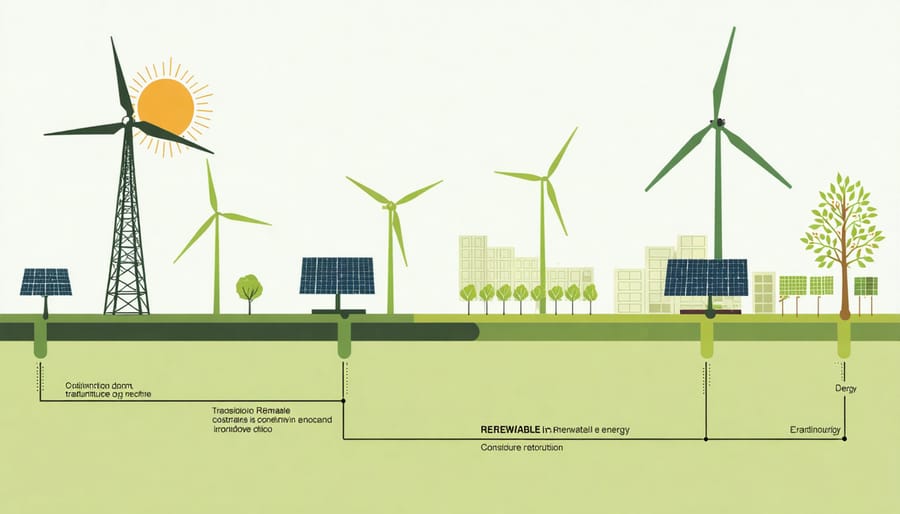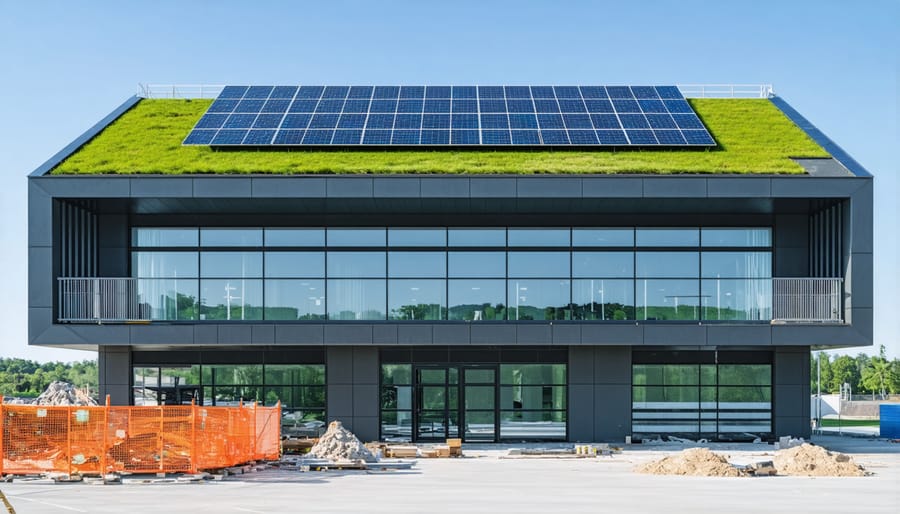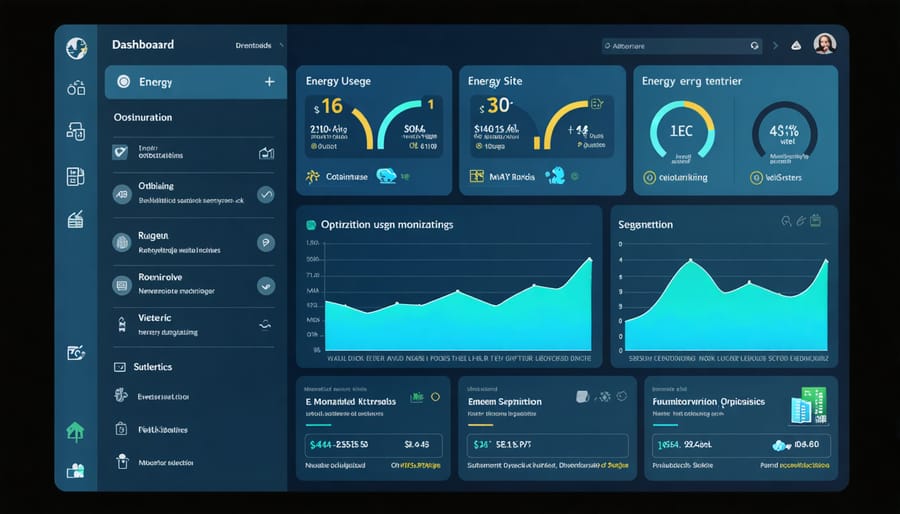The global shift from fossil fuels to renewable energy sources represents one of the most significant industrial transformations in modern history. As construction professionals navigate these energy transition fundamentals, the industry faces unprecedented challenges and opportunities. This systematic evolution encompasses not just the replacement of energy sources, but a complete reimagining of how we design, construct, and operate buildings and infrastructure. From implementing smart grid technologies to integrating renewable energy systems, the energy transition demands a fundamental restructuring of our built environment. For construction leaders, understanding this transformation is crucial as it shapes everything from material selection to project planning, building operations, and long-term sustainability strategies. The convergence of policy mandates, technological advancement, and market demands has created an urgent imperative for the construction sector to adapt and innovate, making energy transition literacy essential for every industry professional engaged in shaping tomorrow’s built environment.
Understanding Energy Transition in Construction

Key Components of Energy Transition
The energy transition framework relies on three fundamental pillars that work in concert to achieve sustainable transformation in the built environment. First, renewable energy integration in architecture forms the cornerstone, incorporating solar panels, wind energy systems, and geothermal solutions into building designs. This integration requires careful consideration of site conditions, local climate patterns, and building orientation to maximize renewable resource utilization.
Second, energy efficiency measures focus on reducing overall energy consumption through advanced building envelope systems, smart HVAC solutions, and intelligent building management systems. These initiatives typically include high-performance insulation, energy-efficient windows, LED lighting, and automated controls that optimize energy usage based on occupancy patterns and environmental conditions.
The third pillar, decarbonization strategies, encompasses the systematic reduction of carbon emissions through fuel switching, electrification of building systems, and implementation of carbon capture technologies where applicable. This includes transitioning from fossil fuel-based heating systems to electric heat pumps, implementing district heating solutions, and utilizing low-carbon construction materials and methods throughout the building lifecycle.
Driving Forces Behind Construction’s Energy Evolution
The construction industry’s energy transition is being propelled by a convergence of powerful forces. Stringent regulations, such as updated building codes and emissions standards, are mandating more energy-efficient practices across project lifecycles. The EU’s Energy Performance of Buildings Directive and similar regulations worldwide have set ambitious targets for near-zero energy buildings, forcing the industry to adapt rapidly.
Market dynamics are equally influential, with clients increasingly demanding sustainable buildings that offer lower operational costs and enhanced environmental performance. Investment firms and developers are prioritizing projects with strong environmental credentials, recognizing both their market appeal and long-term value retention.
Environmental imperatives, particularly the urgent need to address climate change, are driving innovation in construction methods and materials. The sector, responsible for approximately 38% of global energy-related carbon emissions, faces mounting pressure to reduce its environmental impact. This has catalyzed the adoption of renewable energy systems, energy-efficient technologies, and sustainable building materials.
Additionally, rising energy costs and resource scarcity are compelling construction companies to embrace more efficient practices, making the energy transition not just an environmental imperative but a business necessity.
Practical Implementation Strategies
Building Design and Materials
Building design and materials play a pivotal role in the energy transition, serving as fundamental elements in reducing energy consumption and carbon emissions. Modern architectural approaches prioritize passive design strategies, incorporating features like optimal building orientation, natural ventilation, and daylighting to minimize energy requirements.
High-performance building envelopes utilize advanced insulation materials and smart glazing systems, significantly reducing heating and cooling loads. These elements work in conjunction with innovative technologies such as phase-change materials and dynamic façade systems that adapt to environmental conditions.
Material selection has evolved to emphasize sustainability and energy efficiency. Low-carbon concrete, recycled steel, and engineered wood products are increasingly replacing traditional construction materials. These alternatives not only reduce embodied carbon but often deliver superior thermal performance.
Smart material technologies, including self-healing concrete and thermochromic materials, are revolutionizing building performance. Integration of renewable materials like bamboo and recycled composites further supports the circular economy while maintaining structural integrity.
Energy-efficient design principles now extend beyond individual buildings to encompass district-level planning. This holistic approach considers factors such as microclimate optimization, shared energy systems, and urban heat island mitigation. Building Information Modeling (BIM) enables designers to optimize energy performance through detailed simulations and analysis, ensuring that design decisions support long-term sustainability goals while meeting stringent energy performance standards.

Construction Process Innovation
The construction industry is witnessing a remarkable transformation in building methods and technologies aimed at reducing energy consumption throughout project lifecycles. Advanced Building Information Modeling (BIM) systems now enable architects and engineers to simulate and optimize energy performance before breaking ground, resulting in designs that are inherently more energy-efficient.
Prefabrication and modular construction techniques have emerged as game-changers, reducing on-site energy usage by up to 67% compared to traditional methods. These approaches minimize waste, optimize material usage, and significantly decrease transportation-related energy consumption. Manufacturing building components in controlled factory environments allows for precise quality control and enhanced thermal performance.
Innovative materials and construction techniques are revolutionizing the industry. Self-healing concrete reduces maintenance requirements and extends building lifespans, while phase-change materials integrated into building envelopes actively manage thermal loads. Smart construction equipment featuring hybrid or electric powertrains has begun replacing conventional diesel machinery, dramatically reducing site emissions and energy consumption.
Digital twin technology enables real-time monitoring and optimization of construction processes, identifying energy inefficiencies and enabling immediate corrections. Combined with IoT sensors and AI-driven analytics, these systems create a feedback loop that continuously improves energy performance throughout the construction phase and beyond.
Contractors are increasingly adopting lean construction principles, implementing just-in-time delivery systems and optimizing workflow sequences to minimize energy waste. This systematic approach to construction process innovation is proving essential in meeting ambitious energy transition goals while maintaining project efficiency and cost-effectiveness.
Smart Energy Management Systems
Digital technology has revolutionized how buildings manage and optimize their energy consumption through advanced smart energy management solutions. These systems integrate IoT sensors, artificial intelligence, and cloud computing to provide real-time monitoring and automated control of building energy systems.
At the core of these platforms are smart meters and sensors that continuously collect data on energy usage patterns, occupancy levels, and environmental conditions. Advanced analytics engines process this information to identify inefficiencies and optimization opportunities, while machine learning algorithms adapt building systems to maximize energy performance.
Key features include demand response capabilities, which automatically adjust energy consumption based on grid conditions and pricing signals, and predictive maintenance that identifies potential equipment issues before they impact efficiency. Building automation systems (BAS) coordinate HVAC, lighting, and other systems to maintain optimal comfort while minimizing energy waste.
Industry case studies demonstrate that smart energy management systems typically reduce building energy consumption by 15-30%. For example, a commercial office complex in Singapore implemented AI-driven controls that achieved 25% energy savings within the first year of operation.
These systems also support sustainability reporting and compliance requirements by providing detailed energy performance data and automated documentation. As energy prices and environmental regulations continue to evolve, smart management systems have become essential tools for successful energy transition strategies.

Overcoming Implementation Challenges
Technical and Financial Barriers
The transition to sustainable energy systems faces significant technical and financial hurdles that require careful consideration and strategic planning. From an infrastructure perspective, upgrading existing power grids to accommodate renewable energy sources demands substantial modifications to transmission systems and storage capabilities. The intermittent nature of renewable energy sources like solar and wind power necessitates advanced energy storage solutions, which currently represent a major technical challenge.
Cost remains a primary barrier, with initial capital expenditure for renewable energy installations often exceeding traditional energy infrastructure investments. While operational costs typically decrease over time, the upfront investment can be prohibitive for many organizations. This includes expenses related to equipment procurement, installation, system integration, and workforce training.
Grid stability and reliability present additional technical challenges. The integration of various renewable energy sources must be carefully managed to maintain consistent power supply and prevent system overloads. This requires sophisticated control systems and smart grid technologies, which add to the overall project costs.
Furthermore, the construction industry faces specific challenges related to building retrofits and new construction standards. Upgrading existing structures to accommodate renewable energy systems often involves complex structural modifications and system integration work. The need for specialized expertise and equipment can drive up project costs and extend implementation timelines.
These barriers, while significant, are gradually being addressed through technological advancement, innovative financing models, and improving economies of scale in renewable energy production.
Solutions and Support Systems
To facilitate the energy transition, numerous support systems and solutions are available to construction industry professionals. Government incentives, including tax credits and grants, provide significant financial backing for sustainable construction projects. The Federal Energy Management Program (FEMP) offers comprehensive resources and technical assistance for implementing energy-efficient retrofitting strategies and renewable energy systems.
Industry partnerships and collaborations play a crucial role in knowledge sharing and resource optimization. Organizations like the U.S. Green Building Council (USGBC) and the International Renewable Energy Agency (IRENA) provide certification programs, technical guidelines, and best practices documentation. These resources help construction professionals navigate complex sustainability requirements and ensure compliance with evolving energy standards.
Financial institutions have developed specialized funding mechanisms, including green mortgages and sustainable infrastructure bonds, to support energy transition projects. Additionally, Energy Service Companies (ESCOs) offer performance contracting solutions that minimize upfront costs while guaranteeing energy savings.
Digital tools and software platforms enable precise energy modeling, performance monitoring, and optimization. Building Information Modeling (BIM) systems integrate energy analysis capabilities, helping teams make informed decisions during design and construction phases. These technological solutions, combined with professional training programs and certification pathways, create a robust support ecosystem for successful energy transition implementation.
Future Outlook
The construction industry’s energy transition journey is poised for significant transformation over the next decade. Industry experts project that by 2030, renewable energy integration in construction projects will become standard practice rather than an exception. This shift will be driven by advancing technologies, stricter regulations, and increasing market demand for sustainable buildings.
Emerging technologies like artificial intelligence and machine learning are expected to revolutionize energy management systems, enabling real-time optimization of building energy consumption. Smart building technologies will evolve to incorporate more sophisticated sensors and automated controls, leading to unprecedented levels of energy efficiency.
The future of construction materials is equally promising, with innovative products like transparent solar cells, energy-storing concrete, and self-healing materials gaining traction. These advancements will enable buildings to generate and store their own energy while maintaining structural integrity for longer periods.
Industry analysts predict a surge in retrofit projects as existing buildings adapt to new energy standards. This trend will create significant opportunities for construction professionals specializing in energy-efficient renovations and upgrades.
The role of hydrogen in construction energy systems is expected to grow, particularly in heavy machinery and industrial processes. Many construction companies are already investing in hydrogen-powered equipment as part of their decarbonization strategies.
Digital twins and building information modeling (BIM) will become increasingly crucial in energy planning and management. These tools will enable more accurate energy consumption predictions and optimize building performance throughout its lifecycle.
Looking ahead, the construction sector will likely see increased collaboration between traditional building practices and clean energy technologies. This integration will create new job roles and specializations, requiring construction professionals to develop expertise in sustainable building practices and energy management.
The success of this transition will depend largely on industry adaptation and workforce upskilling. Construction companies that embrace these changes early will be better positioned to meet future market demands and regulatory requirements.
The energy transition represents a fundamental shift in how the construction industry approaches power generation, resource utilization, and sustainable development. As we’ve explored throughout this article, successful implementation requires a coordinated effort across multiple stakeholders, from architects and engineers to project managers and policy makers.
Key takeaways for construction professionals include the importance of integrating renewable energy systems into building designs, adopting energy-efficient technologies, and implementing smart building management systems. The transition demands a holistic approach, considering both immediate project requirements and long-term sustainability goals.
To effectively participate in the energy transition, construction professionals should:
– Regularly update their knowledge of emerging green technologies and sustainable building practices
– Invest in workforce training for new energy systems installation and maintenance
– Develop partnerships with renewable energy suppliers and technology providers
– Create detailed energy transition plans for both new construction and retrofitting projects
– Monitor and measure energy performance to demonstrate ROI and environmental impact
The success of energy transition initiatives relies heavily on the construction industry’s commitment to innovation and sustainability. By embracing these changes now, construction professionals can position themselves at the forefront of this global transformation, creating buildings and infrastructure that will serve as benchmarks for future development. The path forward requires continuous adaptation and learning, but the benefits – both environmental and economic – make this journey essential for the industry’s future.

